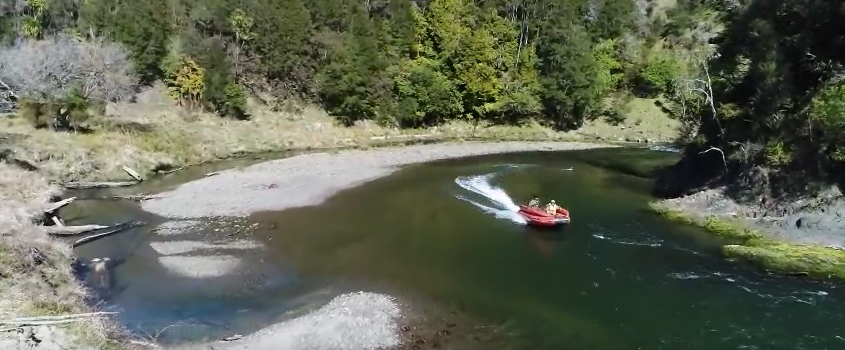Driving Safely Upriver this Hunting Season

Hunting season is upon us, and for those who are passionate about the hunt, getting to the perfect spot is key. Jet boats offer many advantages that make them a popular choice for deer hunting. Their speed allows hunters to cover large areas of river quickly, ensuring they don't miss any opportunities.
Hunters can quickly move upstream and downstream, even in swift water, which makes it easier to get to prime hunting spots.
Safety First
However, it is important to keep in mind that there are restrictions on motor usage, and safety should always be a top priority. All passengers should wear personal flotation devices (PFDs) at all times. Additionally, the driver should be aware of the safe speed operation regulations, especially near bridges, and in areas with slow-no wake speed restrictions.
Before embarking on a jet boating trip, it is important to check water levels and understand the river's conditions. Heavy rain and other factors can create dangerous conditions and should be taken into account.
Conditions to Consider Before Jet Boating Upriver
When planning a jet boating trip upriver during hunting season, there are a few conditions to consider beforehand which may affect the safety and success of your hunt.
In this article, we'll cover everything you need to know about water levels, river conditions, motor usage restrictions, and more to ensure a safe and enjoyable jet boating experience.
Heavy Rain and Flooded Rivers
Jet boating upriver during hunting season can be an exciting experience. However, there are several dangers that can arise unexpectedly, especially during or immediately after heavy rain. These conditions can make navigating upstream difficult and pose risks to boaters who are not prepared.
One of the most significant hazards during heavy rain is the quick rise in water levels. This sudden increase can raise submerged objects and rock dikes that can cause significant damage to boats. It's essential to monitor weather forecasts, which can predict heavy rainfall and increasing water levels.
In these conditions, you will need to reduce speed and remain alert to possible dangers.
Gravel Bars and Shallow Water Areas
When navigating through shallow water areas and gravel bars, it's important to be aware of the significant risks to boats and passengers.
Fortunately with a jet boat, the shallow draft means you can navigate safely up very shallow areas but you still need to pick you line carefully to prevent running aground. If this does happen then you will need to hop out and pull the boat back into deeper water. The extra armour on the base of our boats will prevent any damage to the boat but your driver will need to be aware not to run the boat aground.
Gravel bars are another hazard to watch out for during jet boating expeditions. These areas typically consist of shallow, rocky terrain which can be particularly treacherous during heavy rainfall or an increase in water levels, exposing submerged rocks or create new hazards.
The Right Motor
Recommended boat motor sizes for navigating these areas include 18-horsepower motors, 25-horsepower motors, and 40-horsepower motors. These smaller motors provide greater maneuverability and can keep the boat from making contact with rocks or other obstacles.
Boaters should be also be on the look-out for submerged rocks or other obstacles that may not be visible from the surface. Striking a submerged object at high speeds can cause significant damage to boat motors.
Safety Gear & Equipment
When planning your hunting trip on a jet boat, it is critical to prioritize safety. Here is some safety gear and equipment you will need to take:
-
Life Jackets or Personal Floatation Devices (PFDs): When on a jet boat, life jackets or PFDs are crucial as they can prevent drowning and keep you afloat if you accidentally fall into the water. Make sure to have a properly fitting jacket for each person on board. Wearing these jackets is not only safe but also required by law.
-
Emergency Equipment: In case of emergencies, having appropriate emergency equipment on board can be a lifesaver. This equipment includes a first aid kit, fire extinguisher, sound device, navigation lights, and 100 feet of line. Before setting off on your trip, make sure to check if all the equipment is in good working order.
-
Appropriate Clothing: Jet boating can be risky and expose you to the elements. To remain safe and comfortable, wear protective clothing such as hats, sunglasses, sunscreens, and waterproof jackets. Hypothermia can occur during cold weather, so always carry dry clothing in a waterproof container to protect yourself from the elements. This gear is especially crucial during hunting season when water levels can be unpredictable.
-
Understand River Conditions: It is important to understand the current river conditions before embarking on your jet boating adventure. Check with local authorities or websites that provide the most recent information on water levels, currents, and seasonal restrictions. By knowing the current river conditions, you can better prepare yourself for the journey and keep yourself safe.
-
Boating Restrictions: Make sure to check the boating restrictions in the area beforehand. You need to know if there are motor restrictions or seasonal limits on boating to avoid fines and penalties. Familiarize yourself with the regulations, review them with your group, and strictly adhere to them.
In conclusion, jet boating upriver this hunting season can present many challenges and dangers. But by taking the necessary safety measures, you can reduce the risks and enjoy the experience safely.


